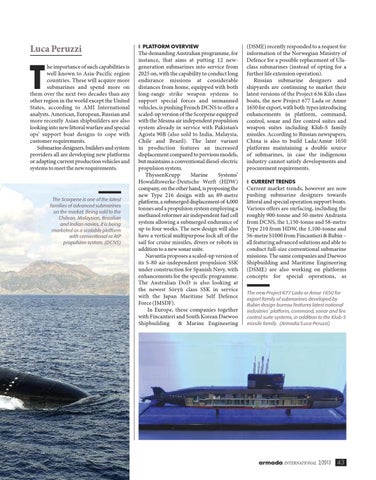Submarine Technology.qxp:Armada
4/1/13
1:25 PM
Luca Peruzzi
T
he importance of such capabilities is well known to Asia-Pacific region countries. These will acquire more submarines and spend more on them over the next two decades than any other region in the world except the United States, according to AMI International analysts. American, European, Russian and more recently Asian shipbuilders are also looking into new littoral warfare and special ops’ support boat designs to cope with customer requirements. Submarine designers, builders and system providers all are developing new platforms or adapting current production vehicles and systems to meet the new requirements.
The Scorpene is one of the latest families of advanced submarines on the market. Being sold to the Chilean, Malaysian, Brazilian and Indian navies, it is being marketed as a scalable platform with conventional or AIP propulsion system. (DCNS)
Page 3
I PLATFORM OVERVIEW
The demanding Australian programme, for instance, that aims at putting 12 newgeneration submarines into service from 2025 on, with the capability to conduct long endurance missions at considerable distances from home, equipped with both long-range strike weapon systems to support special forces and unmanned vehicles, is pushing French DCNS to offer a scaled-up version of the Scorpene equipped with the Mesma air independent propulsion system already in service with Pakistan’s Agosta 90B (also sold to India, Malaysia, Chile and Brazil). The later variant in production features an increased displacement compared to previous models, but maintains a conventional diesel-electric propulsion system. ThyssenKrupp Marine Systems’ Howaldtswerke-Deutsche Werft (HDW) company, on the other hand, is proposing the new Type 216 design with an 89-metre platform, a submerged displacement of 4,000 tonnes and a propulsion system employing a methanol reformer air independent fuel cell system allowing a submerged endurance of up to four weeks. The new design will also have a vertical multipurpose lock aft of the sail for cruise missiles, divers or robots in addition to a new sonar suite. Navantia proposes a scaled-up version of its S-80 air-independent propulsion SSK under construction for Spanish Navy, with enhancements for the specific programme. The Australian DoD is also looking at the newest Sōryū class SSK in service with the Japan Maritime Self Defence Force (JMSDF). In Europe, these companies together with Fincantieri and South Korean Daewoo Shipbuilding & Marine Engineering
(DSME) recently responded to a request for information of the Norwegian Ministry of Defence for a possible replacement of Ulaclass submarines (instead of opting for a further life extension operation). Russian submarine designers and shipyards are continuing to market their latest versions of the Project 636 Kilo class boats, the new Project 677 Lada or Amur 1650 for export, with both types introducing enhancements in platform, command, control, sonar and fire control suites and weapon suites including Klub-S family missiles. According to Russian newspapers, China is also to build Lada/Amur 1650 platforms maintaining a double source of submarines, in case the indigenous industry cannot satisfy developments and procurement requirements. I CURRENT TRENDS
Current market trends, however are now pushing submarine designers towards littoral and special operation support boats. Various offers are surfacing, including the roughly 900-tonne and 50-metre Andrasta from DCNS, the 1,150-tonne and 58-metre Type 210 from HDW, the 1,100-tonne and 56-metre S1000 from Fincantieri & Rubin – all featuring advanced solutions and able to conduct full-size conventional submarine missions. The same companies and Daewoo Shipbuilding and Maritime Engineering (DSME) are also working on platforms concepts for special operations, as The new Project 677 Lada or Amur 1650 for export family of submarines developed by Rubin design bureau features latest national industries’ platform, command, sonar and fire control suite systems, in addition to the Klub-S missile family. (Armada/Luca Peruzzi)
INTERNATIONAL
2/2013
43
